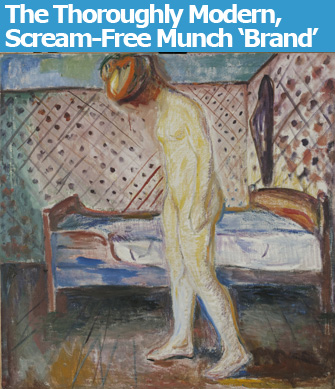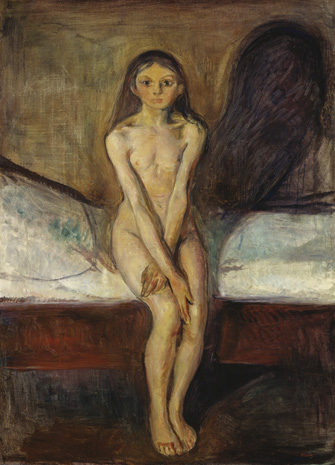 |
|
“Weeping Woman” (1907) © Munch Museum/Munch-Ellingsen Group/BONO 2011 © Adagp, Paris 2011 |
Edvard Munch’s “The Scream,” the artist’s best-known and most reproduced image, is nearly as iconic as Leonardo’s “Mona Lisa,” to the point where it …
 |
|
“Weeping Woman” (1907) © Munch Museum/Munch-Ellingsen Group/BONO 2011 © Adagp, Paris 2011 |
Edvard Munch’s “The Scream,” the artist’s best-known and most reproduced image, is nearly as iconic as Leonardo’s “Mona Lisa,” to the point where it has become something of a cliché. The famed screaming head is nowhere to be seen and, strangely, is not even mentioned in the new exhibition on the artist at the Centre Pompidou, “Edvard Munch: L’Œil Modern” (“Edvard Munch: The Modern Eye”), presumably because the curators wanted to stress an aspect of the artist’s work other than the anguish portrayed in “The Scream” (or maybe they just weren’t able to borrow a version of the oft-stolen painting).
The point methodically elaborated in the show is that Munch (1863-1944) was more than just the lonely, tortured artist whose screaming head represented his own state of mind: he was also a thoroughly modern artist who was constantly incorporating new techniques and technologies into his work and who was keenly aware of and actively involved in the world around him.
While that is true and is amply illustrated in the show, it is also well known that Munch suffered greatly from anguish, depression, heavy drinking and suicidal thoughts at various times. He nevertheless lived a long, full life, divided between his native Norway, Paris and Germany, and seems to have grown more content with life as his success grew.
Munch dabbled in many styles popular in his lifetime – among them naturalism, Impressionism, Post-Impressionism, Symbolism, Synthetism and Expressionism – but he was very much his own artist. In most cases, his work can’t really be described as beautiful but as interesting, sometimes bewildering, and even after taking in the lessons of this exhibition, it seems to me that his works really are more a reflection of his psychology than his modernity.
This show is divided into 12 non-chronological sections representing the “modern” aspects of Munch’s art and focusing on the work he did in the 20th century, when he painted the bulk of it, rather than the 19th.
“Repetition” is the first theme treated. For various reasons, Munch repainted many of the same subjects over the years, most notably “The Sick Child,” inspired by the death of a beloved sister when he was 14 years old, an especially sad moment in a youth marked by the death of loved ones and general gloom. Here we have a couple of versions of that tragic death-bed scene, along with different versions of “Puberty,” portraying a naked young girl sitting on the edge of a bed
 |
|
Above, the1894-95 version of “Puberty” (© Nasjonalmuseet for kunst, arkitektur og design, Oslo, Norvège © Adagp, Paris 2011). Below, the 1914-15 version (© Munch Museum/Munch-Ellingsen Group/BONO 2011 © Adagp, Paris 2011). |

looking at the viewer, her legs clamped together and her arms crossed over them. In the 1894-95 version, a black shape, recognizable as the disproportionately large back of the head of a woman with long black hair, sits on the bed next to the girl. In the more colorful, more Expressionist 1914-16 version, the girl sits in exactly the same position, but the head beside her has become an unidentifiable black blob, still menacing but not as explicitly so.
The later version of “Girls on the Bridge” is much brighter and more cheerful than the first one shown – the girls no longer look like they are about to jump off the bridge but rather as if they are simply enjoying the view. The later versions of “Vampire in a Forest” and “The Lonely Ones” are also far brighter than their predecessors. It is hard to deny the cathartic value these repetitions must have had for Munch as he battled with his demons, but the curators see them more as modern experiments in “reproducibility” as he reworked these themes in other media (other sources indicate that he did this because he hated to part with his paintings but needed to earn a living by selling his work).
Munch’s experiments with photography and film are also taken as proof of his modernity, as are his distortions of pictorial space, which were influenced by his study of new trends in the theater at the time (he worked with Max Reinhardt and was a friend of August Strindberg).
The curators have set out to rescue Munch from the psychologizing of his work, but it seems that this is one artist whose work is inextricably bound up with the events of his life even while he constantly searched for new ways to express his obsessions. While it is certainly true – and this show demonstrates it – that he was open to the world and absorbed other influences, it is clear that his life had a strong effect on his work.
No matter. Any excuse is a good one to show a large group of this fascinating artist’s work, although the catalog’s assertion that “Munch’s constant return to a few identical, unchanging themes helped create his own brand” is enough to make you scream.
Centre Pompidou: 19, rue Beaubourg, 75004 Paris. Tel.: 01 44 78 12 33. Open 11am-9pm. Closed Tuesday. Métro: Rambuteau. Admission: €10-12. Through January 9. www.centrepompidou.fr
Reader Kathleen Gray writes: “Your conclusion made me laugh. Munch would be turning in his grave at the idea he had created a ‘brand’. I agree with your point that no matter how much the curators made their point about his modernity, there’s no escaping the influences of his life and state of mind on his work, but it still makes for an exhibition well worth seeing.”
Reader Reaction: Click here to respond to this article (your response may be published on this page and is subject to editing).
Please support Paris Update by ordering books from Paris Update’s Amazon store at no extra cost. Click on your preferred Amazon location: U.K., France, U.S.
More reviews of Paris art shows.
© 2011 Paris Update
